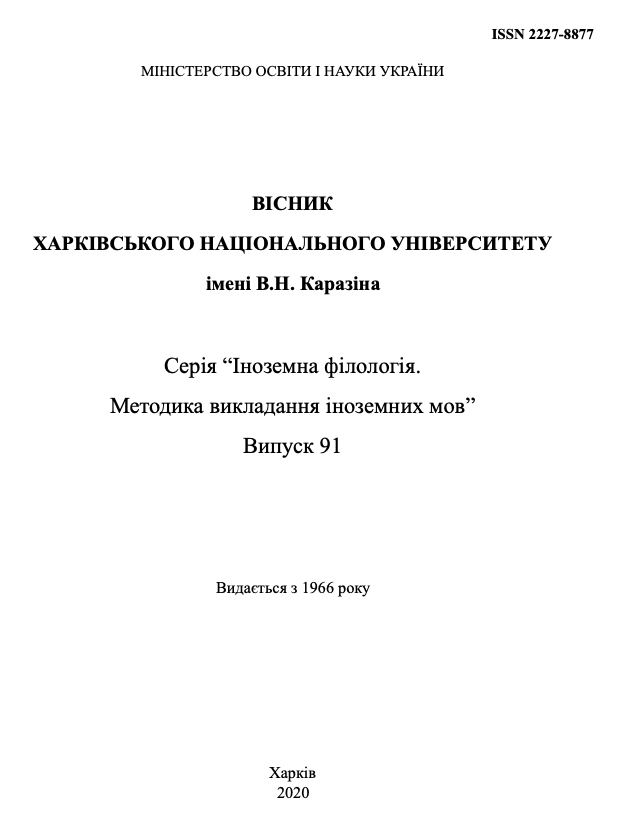РЕАЛІЗАЦІЯ СТРАТЕГІЇ ОДОМАШНЕННЯ У ПЕРЕКЛАДАХ КАЗОК ОСКАРА УАЙЛЬДА
Анотація
У статті проаналізовано стратегії перекладу, використані у перекладі казок О. Уайльда українською та російською мовами. Казки О. Уайльда не слід сприймати як суто дитячі, хоча вони, як правило, належать до «дитячої літератури». Відкидаючи ідею «мистецтво заради мистецтва», автор торкається низки тем, таких як: краса, милосердя, щедрість, тощо. При цьому його твори мають усі істотні риси літературної казки. Це важливо в аспекті перекладу, з огляду на стійку і багаторічну традицію цього жанру в українській та російській літературі. Метою дослідження було виявити тактики та засоби, що використовуються перекладачами у межах двох основних стратегій – одомашнення та очуження. Матеріалом дослідження є дві казки О. Уайльда – «Соловей і троянда» та «Щасливий принц» та їхні переклади українською та російською мовами. Два українські переклади та два російські належать відомим висококваліфікованим перекладачам: Т. Некряч, І. Корунцю, К. Чуковському, М. Благовєщенській; в той час як два інші (на російську мову) виконані маловідомими перекладачами і доступні лише в електронних версіях. Результати дослідження дають підстави стверджувати, що всі перекладачі обрали стратегію одомашнення. Ця стратегія включає такі тактики: структурно-семантична адаптація (додавання суфіксів, змішана афіксація); семантична адаптація (генералізація, конкретизація, модуляція); лексико-семантична адаптація (вилучення, додавання, комплексна трансформація); стилістично-семантична адаптація (заміна нейтральних лексичних одиниць мови оригіналу на розмовні та діалектні у мовах перекладу). Найбільш продуктивним виявився прийом суфіксації, активно застосований досвідченими перекладачами. Це можна пояснити (1) мовними відмінностями, тобто значно більшою кількістю зменшувально-пестливих суфіксів в українській та російській мовах та їх здатністю поєднувати значення «малого розміру» з позитивно-оцінним значенням; (2) типовим використанням слів, які містять такі суфікси, в українських та російських казках, що дозволяє юним читачам відчути себе у звичному світі рідної мови та літератури.
Завантаження
Посилання
Andreiko, L.V. (2015). Stratehii ochuzhennia ta odomashnennia pry perekladi intertekstualnykh odynyts u khudozhnomu tvori [Application of foreignization and domestication strategies while translating intertextual units in literary texts]. Filolohichni traktaty [Philological Treatises], 7(3). Available at: http://oaji.net/articles/2016/3034-1456218919.pdf. (in Ukrainian)
Kazakova, T.A. (2001). Prakticheskie osnovy perevoda [Practical Foundations of Translation]. Sankt-Peterburg: Sojuz Publ. (in Russian)
Koptilov, V.V. (1972). Pershotvir i pereklad [Original Work and Translation]. Kyiv: Dnipro Publ. (in Ukrainian)
Kravchuk, I.V. (2010). Khudozhnii pereklad yak vazhlyvyi chynnyk mizhkulturnoi komunikatsii [Artistic Translation as an Important Aspect of Inter-Cultural Communication]. Naukovyi visnyk Volynskoho natsionalnoho universytetu im. Lesi Ukrainky. [Scientific Bulletin of Lesia Ukrainka Volyn' National University], 2, 60–63. (in Ukrainian)
Popovych, A. (1980). Problemy hudozhestvennogo perevoda [The Problems of Literary Translation]. Moskva : Vysshaja shkola. Publ. (in Russian)
Potapova, A.Ye. (2009). Dytiacha literatura: pidkhody ta kryterii perekladu [Children’s Literature: Approaches to Translation and Translational Criteria]. Visnyk Zhytomyrskoho derzhavnoho universytetu imeni Ivana Franka. [Proceedings of Zhytomyr Ivan Franko State University], 49, 193–197. (in Ukrainian)
Sytenko, O. (2009). Typolohiia mizhrivnevykh zasobiv vyrazhennia katehorii deminutyvnosti v anhliiskii ta ukrainskii movakh [Typology of Interlevel Means of Expressing the Category of Diminutiveness in the English and Ukrainian Languages]. Linhvistychni studii: zb. nauk. prats [Linguistic Studies: Collection of Papers]. Donetsk: DonNU, 19, 167–171. (in Ukrainian)
Sufiksy v anhliiskii movi z riznymy chastynamy movy [Suffixes in the English Language with Different Parts of Speech]. Available at: http://poradu24.com/english/sufiksi-v-anglijskij-movi-z-riznimi-chastinami-movi.html. (in Ukrainian)
Uaild, O. (2011). Zorianyi khlopchyk : per. z anhl. T. Nekriach [The Happy Prince: transl. by T. Nekriach]. Kyiv: Kraina Mrii. (in Ukrainian).
Uajl'd, O. (1979). Mal'chik-zvezda. Skazki: dlja ml. i sredn. vozr. : per. s angl. I. V. Korunca [The Happy Prince: transl. by I. V. Korunec]. Kiev: Veselka. (in Russian)
Uajl'd, O. Solovej i Roza : per. s angl. I. Saharova [The Nightingale and the Rose: transl. by I. Saharov]. Available at: http://az.lib.ru/ u/uajlxd_o/text_1888_thenightingaleandtherose-saharov.shtml (in Russian).
Uajl'd, O. Solovej i Roza : per. s angl. M. Blagoveshhenskoj [The Nightingale and the Rose: transl. by M. Blagoveshhenska]. Available at: http://az.lib.ru/u/uajlxd_o/text_1888_solovey-i-roza.shtml (in Russian).
Uajl'd, O. Schastlivyj Princ : per. s angl. G. Nuzhdina [The Happy Prince: transl. by G. Nuzhdin]. Available at: http://www.lib.ru/WILDE/prince.txt. (in Russian).
Uajl'd, O. Schastlivyj Princ: per. s angl. K. Chukovskogo [The Happy Prince: transl. by K. Chukovsky]. Available at: http://www.lib.ru/WILDE/wildprince.txt. (in Russian).
Yanchenko, Yu.V. (2009). Khudozhno-estetychna svoieridnist kazok Oskara Uailda [Artistic and aesthetic peculiarity of the fiction tales by Oscar Wilde]. Naukovi zapysky Kharkivskoho natsionalnoho pedahohichnoho universytetu imeni H. Skovorody. [Scientific Notes of H.S. Skovoroda Kharkiv National Pedagogical University], 3(59), 44–51. (in Ukrainian)
Beckson, K. (1997). Oscar Wilde: The Critical Heritage. London: Routledge.
Belford, B. (1998). Oscar Wilde Yet Again, and Why. Biography and Source Studies. New York: AMS Press, 31–40.
Bennett, M.Y. (2016). Oscar Wildes Society Plays. New York: Palgrave Macmillan.
Persson, L.-Ch. (1962). Translations of children`s books. Lund: Bibliothekstjaenst.
Smith, E. (2016). Oscar Wildes Historical Criticism Notebook. Oxford: Oxford University Press.
Wilde O. The Happy Prince. Available at: https://www.wilde-online.info/the-happy-prince.html.
Wilde O. The Nightingale and the Rose. Available at: http://www.eastoftheweb.com/short-stories/UBooks/NigRos.shtml.




